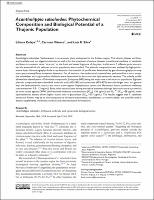| dc.creator | Celaya, Liliana Soledad | |
| dc.creator | Viturro, Carmen Ines | |
| dc.creator | Silva, Luis R. | |
| dc.date.accessioned | 2023-08-22T23:06:55Z | |
| dc.date.available | 2023-08-22T23:06:55Z | |
| dc.date.issued | 2019-06-25 | |
| dc.identifier.citation | Celaya, L.S., Viturro, C. I. y Silva, L. R. (2019). Acantholippia salsoloides : phytochemical composition and biological potential of a thujonic population. Natural Product Communications. Estados Unidos : Sage Publications, 14 (6), pp. 1-7. | es_AR |
| dc.identifier.issn | 1555-9475 | |
| dc.identifier.other | 12380 | |
| dc.identifier.other | CCPI-CNyE-A-089 | |
| dc.identifier.uri | https://hdl.handle.net/20.500.12219/4967 | |
| dc.description | Fil: Celaya, Liliana Soledad. Universidad Nacional de Jujuy. Centro Interdisciplinario de Investigaciones en Tecnologías y Desarrollo Social para el Noa; Argentina. | es_AR |
| dc.description | Fil: Celaya, Liliana Soledad. Consejo Nacional de Investigaciones Científicas y Técnicas. Centro Interdisciplinario de Investigaciones en Tecnologías y Desarrollo Social para el Noa; Argentina. | |
| dc.description | Fil: Celaya, Liliana Soledad. Universidad Nacional de Misiones. Facultad de Ciencias Exactas, Químicas y Naturales. Departamento de Ingeniería Química ; Argentina. | |
| dc.description | Fil: Celaya, Liliana Soledad. Universidade do Porto. Faculdade de Farmácia. Laboratório de Farmacognosia; Portugal. | |
| dc.description | Fil: Viturro, Carmen Ines. Universidad Nacional de Jujuy. Centro Interdisciplinario de Investigaciones en Tecnologías y Desarrollo Social para el Noa; Argentina. | |
| dc.description | Fil: Viturro, Carmen Ines. Consejo Nacional de Investigaciones Científicas y Técnicas. Centro Interdisciplinario de Investigaciones en Tecnologías y Desarrollo Social para el Noa; Argentina. | |
| dc.description | Fil: Silva, Luis R. Universidade da Beira Interior. Centro de Investigação em Ciências da Saúde; Portugal. | |
| dc.description.abstract | Acantholippia salsoloides (Verbenaceae) is an aromatic plant widespread in the Andean region. The infusion (leaves and flowers) is widely used as a digestive stimulant as well as for the treatment of various diseases in traditional medicine. A. salsoloides attributes its common name “rica-rica” to the fresh and sweet fragrance of the plant. In this work, 2 different polar extracts and the essential oil of a selected rica-rica population were studied. The phenolic composition was analyzed by high-performance liquid chromatography diode array detector; the essential oil profile was determined by gas-chromatography ion-trap mass spectrometry/flame ionization detection. For all extracts, the antibacterial potential was performed by in vitro assays; the antioxidant and α-glucosidase inhibition were determined in decoction and hydroethanolic extracts. The volatile profile
allowed the identification of 26 volatile compounds, β-thujone (84%) being the major one in this rica-rica population. Eighteen phenolic compounds were identified; isoferulic acid (16%-18%) and cynaroside (45%-47%) were the larger ones. In a general way, the hydroethanolic extract was more active against Staphylococcus aureus and Micrococcus luteus (minimum inhibitory
concentrations= 0.3- 1.3 mg/mL). Both polar extracts have strong antiradical activities although decoction extract proved to be more active against DPPH• (half-maximal inhibitory concentration [IC50] =36 μg/mL) and O2 ●−(IC50 =28 μg/mL) while hydroethanolic extract shows higher action over α-glucosidase (IC50 =217 μg/mL). The results suggest that A. salsoloides leaves and flowers may be an interesting source of natural antioxidants, antidiabetics, or antimicrobials, and could be used in dietary supplements, medicinal products and pharmaceutical formulations. | es_AR |
| dc.format | application/pdf | |
| dc.format.extent | 360 KB | |
| dc.language.iso | eng | es_AR |
| dc.publisher | Sage Publications | es_AR |
| dc.relation | info:eu-repo/semantics/altIdentifier/hdl/http://hdl.handle.net/11336/105425 | |
| dc.relation | info:eu-repo/semantics/altIdentifier/doi/http://dx.doi.org/10.1177/1934578X19858542 | |
| dc.relation | info:eu-repo/semantics/altIdentifier/urn/http://journals.sagepub.com/doi/10.1177/1934578X19858542 | |
| dc.rights | info:eu-repo/semantics/openAccess | |
| dc.subject | Acantholippia salsoloides | es_AR |
| dc.subject | β-thujone | es_AR |
| dc.subject | Isoferulic acid | es_AR |
| dc.subject | Cynaroside | es_AR |
| dc.subject | Biological action | es_AR |
| dc.title | Acantholippia salsoloides : phytochemical composition and biological potential of a thujonic population | es_AR |
| dc.type | info:eu-repo/semantics/article | es_AR |
| dc.type | info:ar-repo/semantics/artículo | |
| dc.type | info:eu-repo/semantics/publishedVersion | |



